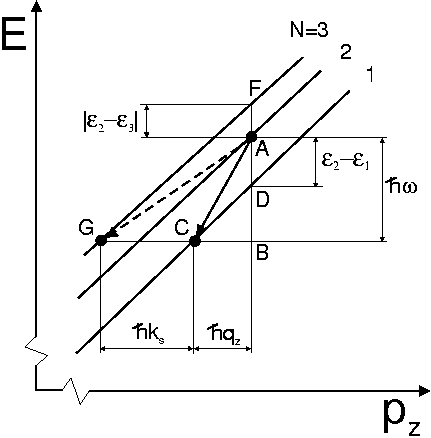|
The interaction of a channeled relativistic charged particle with a standing ultrasonic wave excited in a single crystal leads to the splitting of the projection of its momentum in the channeling direction (z) : pzÞ (pz- ks , pz , pz+ ks , pz , pz+ ks). Here ks). Here  ks denotes the momentum associated with an acoustic phonon.
The wave function of the channeled particle then represents a superposition
of three plane waves with the phases (pz-n ks denotes the momentum associated with an acoustic phonon.
The wave function of the channeled particle then represents a superposition
of three plane waves with the phases (pz-n  ks) z/ ks) z/ , n = 0,±1. , n = 0,±1.
Theoretical considerations on the influence of ultrasound (US) on
channeling [1] formally predict the occurrence of additional radiative transitions which may amplify the total intensity of channeling radiation (CR). The mechanism of this effect instantly becomes reasonable from the following graphical treatment of CR.
Fig. 1 schematically illustrates the dispersion
relation [2] E = c Ö{m2c2+pz2} + eN of a
channeled particle for three stationary states (N = 1, 2, 3) of
transverse motion with the energy levels eN. Because of E >> | eN | the slope of these curves ¶E / ¶pz » vz is determined by the particle velocity (vz). By applying DE / Dpz for the triangles CBD and CBA the known formula for the energy of CR emitted under an angle q due to the transition AC :

can directly be obtained from the ratio of these two expressions. In an analogous way, from the triangles GBA and GBF, one can for instance derive the adequate equation for an inverse transition AG accompanied with the emission of an acoustic phonon :

After such a radiative transition the channeled particle occupies a state with larger transverse energy; i.e. a CR-photon was emitted together with an acoustic phonon, and the quantum number N is increased.
Since in general n = 0,±1 [1], the direct (ei > ef) as well as inverse (ei < ef) radiative transitions associated with the emission or absorption of an acoustic phonon are induced additionally to such with n = 0 which are not influenced by US. Consequently, US enables the channeled particle to emit multiple CR-photons during its traverse through the acoustically excited crystal that should result in an increase of the CR intensity.

Fig. 1 Schematic dispersion curves with two
transitions (arrows) of a channeled particle.
 qz= qz= q cosq denotes the projection of the
photon momentum q = w/c onto the channeling direction. q cosq denotes the projection of the
photon momentum q = w/c onto the channeling direction.
1 Institute of Applied Problems in Physics, NAS Yerevan, Armenia
References
[1] L.Sh. Grigoryan et al., Rad. Eff. & Def. in Sol. 152 (2000) 225; ibid. p. 269; vol. 153 (2000) p. 13
[2] J.O. Kephart, Stanford University, Ph.D. thesis (1987)
IKH
05/29/01
© W. Wagner
|



 ks , pz , pz+
ks , pz , pz+